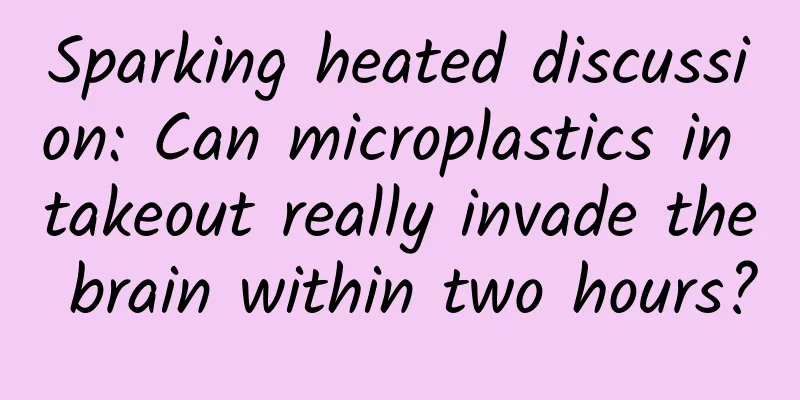Sparking heated discussion: Can microplastics in takeout really invade the brain within two hours?

|
Previously, the topic #Microplastics in takeout can enter the brain within two hours# has attracted widespread attention, which really made everyone sweat and said: "Is it really true that we can no longer eat takeout in the future?" "Plastics are everywhere in our lives, what can we do about it?" Don't worry, today we will take a closer look at microplastics to see what they are, what harm they cause, and how we should deal with them. Zeqiao original copyright contact What are microplastics? Microplastics are super small particles formed by plastics in various processes. How small are they? The smallest is equivalent to 1/500 of the diameter of a hair, and the largest can be seen by the naked eye. The diameter is generally between 0.1-5000 microns. If the diameter is less than 100 nanometers, it is nanoplastic. Where do microplastics come from? There are two main sources of microplastics. On the one hand, industrial production produces primary microplastics used as raw materials, such as plastic microbeads in toothpaste and facial cleansers , which play a role in scrubbing, cleaning, puffing, emulsification, etc. On the other hand, secondary microplastics come from various plastic products, especially disposable items, such as plastic bottles, packaging boxes, plastic bags , etc. Zeqiao original copyright contact How do microplastics enter the human body? Microplastics contaminate food and water through environmental pollution, food chain enrichment, and contact material transfer, and then enter our bodies through what we eat and drink. Drinking water is the worst hit by microplastics. Bottled water, water in paper cups , and even tap water are not immune. In addition, there are also a lot of microplastics in honey, milk, beer, seafood, sugar, rice, fruits and vegetables, animal offal and other foods. Moreover, a study published in Nature in 2019 found that a person may inhale 16.2 plastic fragments from clothes and air every hour, and the number of microplastic particles ingested per week is equivalent to eating a "bank card". Zeqiao original copyright contact These daily necessities contain a lot of microplastics 1. Paper cups and take-away coffee cups: Although they look like they are made of paper, they are lined with plastic film to hold water. When hot drinks are put in them, microplastics will be released crazily. If you take a sip of hot coffee, you may drink microplastics into your stomach. 2. Tea bags: Many tea bags contain plastic . Once soaked in hot water, a large amount of microplastics will escape into the water. The amount of microplastics released from each tea bag is frightening. 3. Plastic cutting board: Lightweight and easy-to-use plastic cutting boards also release microplastics when used, with tens of millions of microplastics released each year. These operations will increase the intake of microplastics 1. Put plastic products into the microwave: Put disposable packaging boxes and food bags directly into the microwave to heat them. Plastic will degrade under the action of microwaves , releasing more microplastics and nanoplastics. Even if it is made of PP material No. 5 that can be put into the microwave, it will not work if the heating time is too long (more than 3 minutes) or if it is filled with oily food. 2. Repeated use of disposable packaging boxes: Disposable packaging boxes have a shelf life and are not suitable for multiple use. In addition, the high-oil and high-temperature cooking style will cause it to age faster and release harmful substances. 3. Use mineral water bottles to store oil, etc.: Mineral water bottles are mostly made of No. 1 PET material, which will degrade in strong acid or alkaline environments . If vinegar, soy sauce, oil, etc. are stored in them for a long time, harmful substances will dissolve out. Zeqiao original copyright contact The harm of microplastics The toxicity of microplastics themselves is related to many factors. The smaller the particles, the greater the harm. Nanoplastics are even more harmful and can quickly penetrate the placenta and blood-brain barrier. It only takes 2 hours from being ingested to being detected in the brain. It may also carry toxic and harmful substances and pathogenic microorganisms, affect reproductive and metabolic health, cause intestinal and liver problems, and even be related to respiratory diseases and chronic diseases. However, the World Health Organization currently says that there is no definite evidence that it directly endangers human health, but this does not mean that there is no harm, it just needs more research. Ways to reduce microplastic intake 1. Reduce plastic waste at the source: actively promote plastic recycling and reduce plastic use. 2. Prevent pollution during the purchasing process: choose stainless steel, glass, and silicone products for food contact ; when buying food, give priority to primary agricultural products, simple packaging or degradable packaging , and bring your own cloth bags and cartons; when handling food ingredients, wash fruits and vegetables before cutting, and remove the internal organs of seafood and animal food. 3. Choose appropriate tableware: Use glass, ceramic, stainless steel or bamboo and wooden tableware to hold food ; use glass or ceramic containers for take-out or heating in the microwave; choose unprinted stainless steel tableware for children. 4. Pay attention to drinking water, tea and coffee: give priority to stainless steel or glass cups, drink direct drinking water, especially boiled water , and use less tea bags and disposable coffee cups. |
<<: Coughing is urgent! A complete guide to whooping cough
>>: Come, give pests a "camelina perfume"
Recommend
Cool effect, Volvo submits patent application for new head-up display
According to foreign media reports, Volvo recentl...
Panasonic exhibits 0.45mm flexible battery: smaller than a credit card
The shape of most wireless devices is determined ...
Will people who live according to the “latest research” live healthier lives?
With the accessibility of information channels to...
Baidu Information Flow 11.11 Marketing Manual!
How is the traffic trend of Baidu Information Flo...
How to increase Internet users!
When it comes to user growth , most people will t...
Why do we need to analyze user behavior?
1. What is user behavior ? User behavior is compo...
How to use the points system to stimulate user retention (Part 2): How to build a reasonable points system
After understanding the relevant concepts of inte...
What is cockroach milk? Do you dare to try a cup?
A while ago, a hot search on Weibo really caught ...
Five suicide attempts in 20 years: Windows Phone is completely finished
Windows Phone has completely failed. On May 23, Mi...
Beginner-level course on learning English by listening to famous books
Course Description This course is the entry-level...
Query the price of Artair Real Estate Mini Program agent. How much is the price of Artair Real Estate Mini Program agent?
How much does the Ateler Property Agency Mini Pro...
How to plan an online event?
Activities are a tool in operations work, and the...
[Promotion] Future applications: No matter how fancy your H5 is, what’s the use if there is no traffic?
Zeno once proposed: Human knowledge is like a cir...
Ctrip and Qunar Competitive Product Analysis Report
Which apps do you refer to when booking travel ti...
Lanzhou WeChat mini program distribution function, how much does it cost to develop a mini program distribution system?
Distributing mini programs is the future developm...









